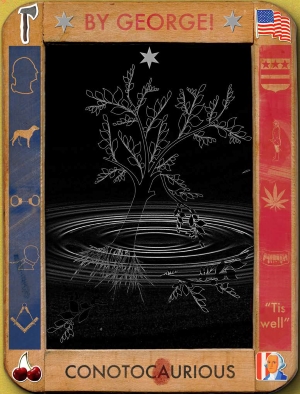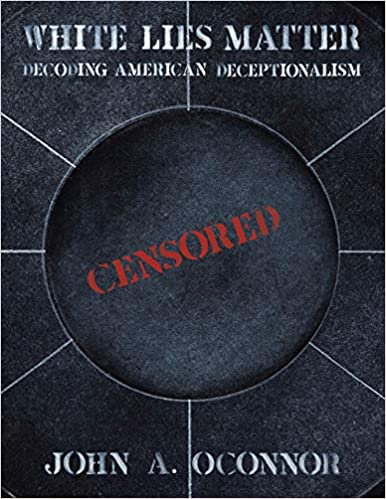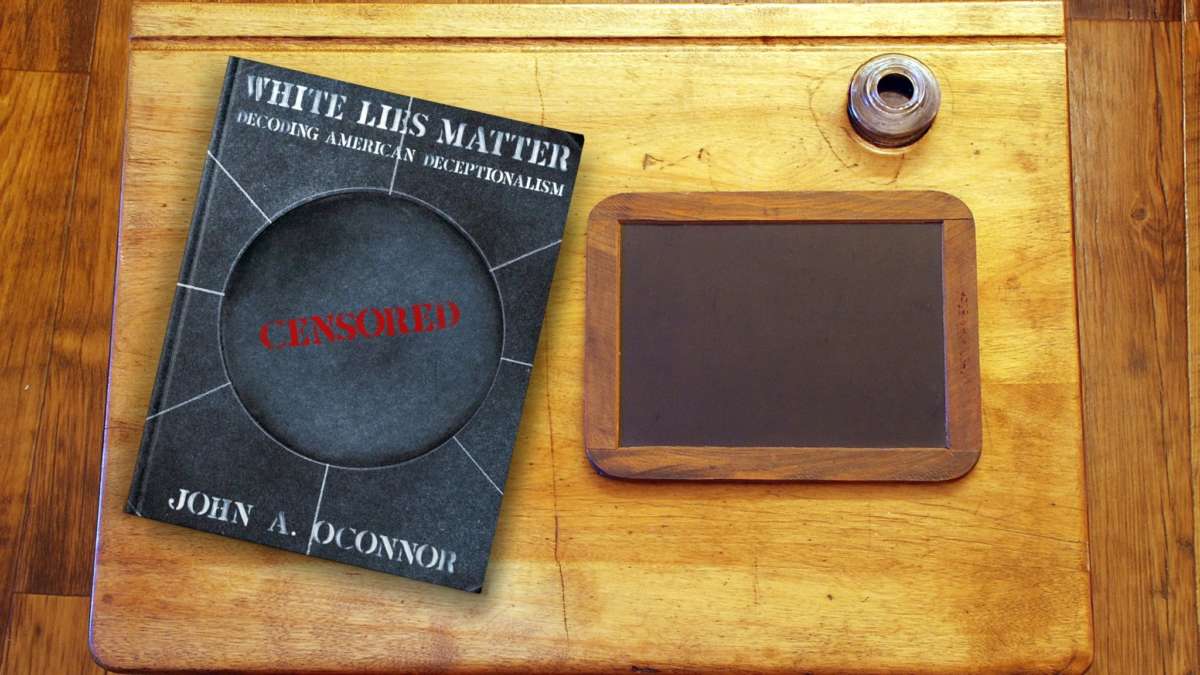White Lies Matter: Decoding American Deceptionalism by John A. O'Connor
Looking at the works of John A. O’Connor in his recent art book, White Lies Matter: Decoding American Deceptionalism, the reader might easily be misled into believing that they are photographs of assemblages. Each is built on a “canvas” of an old-fashioned slate — the kind that kids in schoolhouses used back in the 19th century — covered with smudgy chalk lines, images and words. The slates are overlaid with materials ranging from photographs to engraved plaques, stickers, and other ephemera, and printed upon using various methods such as rubber stamps, woodcuts and stenciling.
But these are not assemblages, at least not of the three-dimensional kind. O’Connor, who has been creating art for over six decades, is known for his masterful trompe l’oeil (“fool the eye”) techniques, especially in his Chalkboard Series. His work utilizes a variety of mediums — acrylic, airbrush, computer-aided design, stencils — to produce a thematic sense of illusion and deception. This new collection is an evolution of this series, as well as a self-contained “spin-off” of it.
Whereas many works in his Chalkboard Series are canvases of a similar dimension to classroom blackboards, his “slates” in White Lies Matter are a more intimate 21 x 17 inches, making them a perfect size to present in a book, because, as you will learn, the details O’Connor puts into his works are important keys and clues (and often, delightful and insightful puns) you don’t want to miss.
A CRITIQUE OF AMERICAN HISTORY AND NATIONALISM
White Lies Matter is more than just an art book, however. It is a social and political critique of America and its history. Each slate relates to an event, era or theme, and is accompanied by a short essay on the topic that asks us to reconsider what we have been taught (or have thought). The book proceeds in chronological order, beginning with Christopher Columbus and the First Thanksgiving, and ending with the foibles of the Trump era.

Between these bookends of history are also many less-familiar moments of national misremembering, like President Grant’s Whiskey Ring Scandal or Harry Jacob Anslinger and the racist origins of the “War on Drugs.” Racism, in fact, is examined throughout many of the works, making this book’s title particularly apt, as provocative as it may be on the surface. These “White lies” are much more dangerous and far more damaging than the common idiom suggests, coming as they do from those in power and positions of privilege, and comprising not only “big lies” but also foundational ones that perpetuate by distorting reality as they are built upon over time.
The author describes his series as “a visual history of American hypocrisy.” It is an apt way to describe this unflinching guide to American nationalism, brutality and self-deception. Each work captures a sense of jarring cognitive dissonance surrounding American identity, featuring haunted fragments of Americana awkwardly situated in relation to the unexamined contradictions of our national myths. The accompanying text describes the precise point at which these myths contradict the realities of American history.
THE DEVILISH DETAILS
But why the slates? The institutional conveyor of received truth, the blackboard is where our Americanness is taught, a window to the world toward which our attention is forced, rather than the one opening out on the world as-it-is (as any daydreaming schoolchild knows, especially on a sunny day). But here, the naïve, quaint schoolhouse slate, where children themselves would write out their lessons, hones the concept to a sharper, more poignant point. It’s not just what we are taught that is cause for alarm; it is what we learn to mimic back, from a very young and impressionable age, until it is what we perceive as fact.
A closer look at the art reveals layers of meaning. The details seem subtly balanced between “found” and slyly, sarcastically “manufactured,” a style the artist calls “conceptual realism” with which he conveys an uneasy, compromised American past with the madness exposed.
The KKK, Dred Scott, suffragettes and Billy Graham are the historical starting points for meditations on the ideological wreckage left in their wake, and the artist provides fragments and clues with their own punning synchronicity scattered across the crime scene. They are like props from the set of a twisted psychological thriller, where an amusement park has fallen into derangement, where the light of day reveals stray evidence, incomplete information, unconvincing comfort, sinister toys and sadistic clowns, an amusement park exposed as a crass, phony backdrop.
Wisps of images appear on the slates, like unnamed zodiacs in the night sky of the mind’s eye, chalk dust of forgotten facts. They float in black voids, anagogic and beyond our control like a wrecked car glimpsed beneath the surface of a frozen lake, undigested fragments faintly identified through layers of consciousness surrounded by a quaint framework of ironic badges and emblems.
AT THE INTERSECTION OF ART AND HISTORY
O’Connor, who was a professor of art for decades before his retirement in 2005, connects his history-themed art to the traditional History Art of Benjamin West and John Singleton Copley and their renderings of contemporaneous events, as well as biblical and Greek and Roman historical moments, the pageantry and heroics replaced by fragmented disillusion. He also takes cues from the political discourse inherent in the works of Bosch, Goya and Hogarth.

This book could serve as a visual companion to Howard Zinn’s People’s History of The United States, or especially James Loewen’s Lies My Teacher Told Me, with its focus on disentangling the yarn of American myth, exposing America’s exceptional gift for self-deception, and revealing an institutional refusal to look at historical realities to the point of excluding uncomfortable truths from the typical American History textbook.
These are slates from a haunted schoolhouse, where cognitive dissonance is the main lesson, revealing how each piece of propaganda fits strategically over a worrisome or uncomfortable truth, where Washington and the cherry tree make the Tuskegee Syphilis Experiment possible, and the student is primed to be victimized. Interacting with these works gives us an understanding of how each lie transmitted on these slates can trigger an atrocity.
This is the world we inherit as we engage in a dreadful confrontation with our own American identity, and these cunning conceptual works illustrate the harrowing task ahead.
White Lies Matter is available for purchase.
https://booktrib.com/wp-content/uploads/2021/02/iuniverse-logo200.jpghttps://booktrib.com/wp-content/uploads/2021/02/john-a-oconnor.jpg




